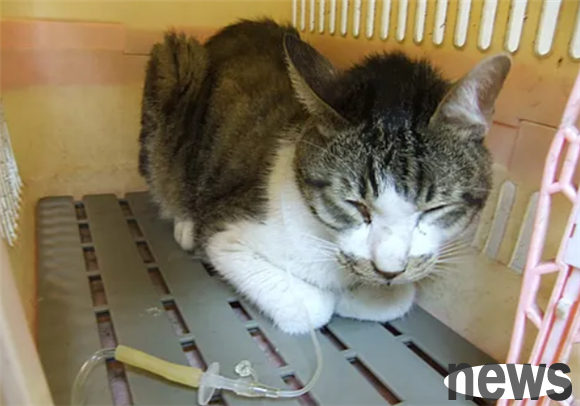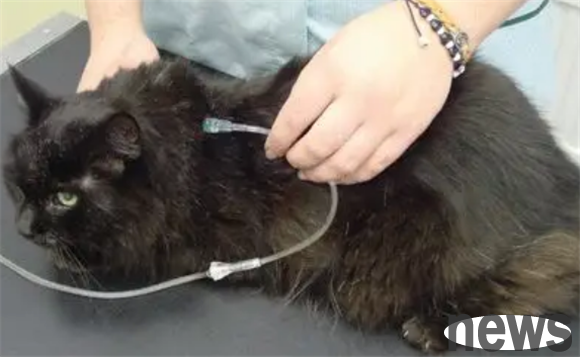As the owner of cats, the biggest wish is to see them enjoy delicious food, have a healthy body, and have a stable sleep. However, when the lively and cute kitten suddenly lost interest in food, his weight dropped significantly, and even reached the point where he needed to rely on tube feeding to maintain his life, this would undoubtedly make every cat shoveler full of worry and anxiety, as if his mood became heavier with the cat's loss of appetite.
Forget it if you don’t eat, don’t even drink water. You can only rely on infusion to maintain the moisture in the body.

The hair is too dirty to be cleaned, and its mouth is very smelly.
The body is so thin that it has lost its muscles. you have to use all your strength to stand up tremblingly.
The above are all sick cats that are deeply suffering from chronic kidney disease.
As one of the common diseases in cats, chronic kidney disease is not easy to be detected in the early stages. It looks completely different from the outside, but it continues to deteriorate slowly inside. When obvious symptoms appear, the situation is no longer optimistic.
In order to let more shovelers know and understand the chronic kidney disease of cats and prevent problems before they happen, Mengzhaojun will give you some popular science on chronic kidney disease.
/01/
What is chronic kidney disease
Chronic Kidney Disease (CKD, Chronic Kidney Disease) refers to persistent structural abnormalities or loss of function in the kidney. Chronic kidney disease is defined as a loss of 30% or more of renal function and the course of the disease is more than 3 months.
According to statistics from a chain pet medical institution in the United States, 1.5% of cats diagnosed with CKD account for 1.5%. Of this 1.5%, cats over 10 years old account for 81%.
The incidence of chronic kidney disease in cats increases with the increase of cats' age, and the probability of CKD in cats over 15 years old is 30%-50%.
The probability of CKD and female cats are the same, but male cats usually suffer from CKD in youth.
Some breeds have a congenital tendency to suffer from CKD, such as Maine, Abyssinian, Siamese and Russian Blue Cats.
If a cat unfortunately suffers from CKD, the lost renal function will be permanently lost and cannot be reversed. What are the clinical symptoms of chronic kidney disease in sick cats with thin, discolored, partially shedded fur,
runny nose and saliva?
✔ Weight loss ✔ Loss of appetite ✔ Hypertension
✔ Odor to breath ✔ Anemia
✔ Polyuria (decreased urine concentration ability)
✔ Thirst (drinking more, decreased urine concentration ability, compensated by drinking more water)
✔ Even if anuric symptoms occur at the end of the development stage (complete loss of renal function → uremia)
✔ Sometimes uremia breathing smell (the gas exhaled by cats has an unpleasant smell of ammonia) or oral ulcers can be observed.
The anterior chamber blood accumulation in the anterior chamber of the eyes caused by CKD and hypertension is often ignored by the owner in the early stage of CKD and is considered to be a normal manifestation of aging.
However, when obvious clinical symptoms appear, such as drowsiness, weakness, anorexia, excessive urine, significant weight loss, vomiting and dehydration, etc., it may have developed to CKD3 or even stage 4. The cat's kidney function may have been lost by more than 75%, so it must be taken to the hospital for timely examination.

A cat with CKD has poor limbs and fur, and
is also dehydrated.
International Kidney Association (IRIS) has formulated the classification of cat kidney disease (based on serum creatinine and SDMA concentration). It only needs to ask the veterinary to check the cat's biochemical indicators to determine it, which is very simple and clear.
The survival time of a sick cat is related to the cat's CKD rating ↓
Based on this table, we can know that if the cat is already at level 3 or 4 of CKD, it may be less than 2 years left before the day when the god of death takes away the hairball!
If the cat is unfortunately diagnosed with CKD, the shoveler must follow the doctor's advice and actively cooperate with the doctor's treatment!
For cats who are already at level 2 or above with chronic kidney disease, eating functional prescription food can assist in the treatment of chronic kidney disease, extend the lifespan of sick cats and improve the quality of life of cats.
Cute Claw Jun reminds everyone: Never think that your cat is young, so you don’t pay attention to it, otherwise you will regret it.
/03/
Protecting the health of cats' kidneys, what can I do?
Regular physical examination
Take the cat to the hospital for physical examination regularly every year. Elderly cats need to have physical examinations once every six months, undergo routine blood, creatinine, urea nitrogen, SDMA, ultrasound, blood pressure, urine routine and other items, focusing on monitoring changes in liver and kidney indicators..
If the cat has abnormalities in the following indicators after the veterinary examination, it can be suspected that the cat is at level CKD1:
01. Abnormal renal area palpation or abnormal renal morphology was found after B-ultrasound examination;
02. Continuous renal proteinuria;
03. Decreased urine concentration ability;
04. Although the SDMA/serum creatinine concentration is within the normal range, it can be seen that it continues to increase over time.
Drink more water and observe the amount of urination
※ Let the cat drink more water, feed the cat canned food, bag wet food, etc., and do not only give dry food, which can greatly reduce the probability of cats suffering from urinary diseases. To lure a cat to drink water, click the link: "If you suffocate a cat, just urinate!!!"
※ When the cat shoveler sees a cat drinking water and going to the toilet in daily life, you must be careful and familiar with the master's urination rules.
The daily urine volume of cats is about 24 to 48 ml/kg, and the amount of urine is closely related to the cat's diet and activity habits.
Since each cat has different living habits, the owner should pay attention to the approximate amount of the cat's urine mass under normal conditions, and can be quickly detected when the cat's urine volume is significantly reduced.
If you observe that the number of times a cat enters and leaves the litter box increases significantly, recording the number and frequency of times and times that you enter and leave the litter box can also help you judge.
Once signs of CKD are found, timely and active treatment should be carried out. Early detection and early diagnosis can significantly extend the lifespan of the cat and improve the quality of life of the cat.
The most feared thing for raising cats is that cats are sick. Apart from their wallet, the cats still suffer from it.
So you can forward this article to the shoveler around you, do your homework in advance, and cats can suffer less.